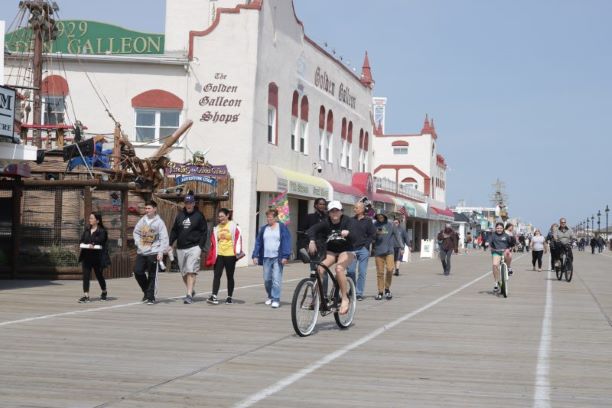By DONALD WITTKOWSKI, OCNJDAILY
How much is 1.2 million cubic yards of sand?
The quick answer is, a lot.
To put it another way, a standard dump truck holds about 14 cubic yards of sand. So, 1.2 million cubic yards is the equivalent of about 86,000 dump trucks of sand.
This is how much fresh sand will be pumped onto Ocean City’s storm-eroded shoreline in the north end of the island as part of a $21.5 million beach replenishment project getting underway in November.
The project will replenish beaches in the city’s northern end starting at the Seaview Road jetty as well as the downtown section up to 14th Street. The area includes a particularly vulnerable stretch of beach at Fifth Street where the dunes are often washed away by storms, leaving steep, cliff-like drop-offs.
Ocean City is exercising an option in the contract for four stockpiles of sand – an additional 10,000 cubic yards of sand in total – for use after the replenishment project is completed.
“Our contractor would leave the sand in these stockpiles for the city to redistribute and shape for local dunes or other use as they see fit,” said Steve Rochette, a spokesman for the U.S. Army Corps of Engineers, the federal agency supervising the replenishment project.
The contractor, Great Lakes Dredge & Dock Co. of Oak Brook, Illinois, has done other beach replenishment projects in Ocean City in the past.
On Nov. 11, Great Lakes is scheduled to begin dredging sand from the Great Egg Harbor Inlet and will pump it onto the beaches through a network of massive pipes. A dredge named Texas will be anchored offshore to collect the sand.
Barring any delays, the beach replenishment project will be finished by early January, City Business Administrator George Savastano said.

Wide powdery beaches are important for summer tourism and to protect the city from the ocean’s wrath.
Restoration projects help the tourist-dependent city to keep its beaches in tip-top shape so it may continue attracting summer vacationers.
Besides the aesthetic value of having wide, powdery beaches, the city will also benefit from the replenishment project by having a bigger barrier of sand and dunes to protect homes, businesses, the Boardwalk and roads from the ocean’s storm surge.
“Our beachfill projects are sacrificial in nature. They are designed to bear the brunt of wave energy during storms and ultimately reduce risk to the infrastructure behind them. This includes boardwalks, roads, utility lines, homes, and businesses,” Rochette said in an email Monday.
Beach restoration in Ocean City initially was done in 1992 and continues on a three-year cycle under a 50-year agreement between the town and the Army Corps of Engineers.
This will be the 10th beachfill project for the north end of Ocean City since the 50-year agreement began, Mayor Jay Gillian said. He praised the partnership involving different levels of government to protect Ocean City from the ocean’s wrath.
Work is designed to reduce damage and erosion from coastal storms. Ocean City’s beaches were pounded for four straight days from heavy surf churned up by the remnants of Hurricane Ian and a nor’easter parked along the Jersey Shore in the first week of October.
“One benefit from the storm we had is that we’re going to get a lot more sand (from the Army Corps of Engineers). My big thing is, beach replenishment protects our property,” Gillian said Saturday in remarks during a community meeting that focused on a series of capital improvement projects planned in Ocean City.
In a separate project estimated to cost $30 million, the shoreline in Ocean City’s south end will be replenished in 2023 along with the beaches in Strathmere and Sea Isle City, it was announced earlier this year. The contract for that project still must be awarded by the Army Corps of Engineers.

A long section of the damaged dunes in the north end is left looking like steep mini-cliffs following Hurricane Ian’s remnants in the first week of October.






